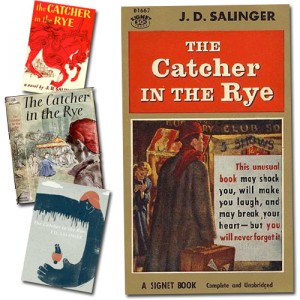
By now anyone with a heartbeat knows that J.D. Salinger passed on, last week. The death of the controversial author of “Catcher in the Rye” was certainly a news event, bringing out the deferential and the snarky. There were reviews and reminiscences, lengthy and brief accountings of his place in literature and his place in American and even world culture. It was in one spontaneous moment a reminder that even the pop minded, celebrity inundated America sometimes remembers its true artists and its literary lions. A nice touch for a country with a memory of its history that is equivalent to a dog.
Salinger only published four books. The first is “The Catcher” in the Rye, published in 1951. He also published “Nine Stores,” “Franny and Zooey,” and “Raise High the Roof Beam Carpenter.” This is a modest literary output but significant on so many levels. To read Salinger is in some way to follow the trajectory of the American family and with it American Culture. At once it is intensely personal. We derive an intimate knowledge of the fictional Glass family, fashioned after Salinger’s own Irish-American Heritage. But we also derive a sense of the dissolution and reformation of the American family.
In Salinger’s intimacy, we find a universal world, a changing sequence of family life that has left us somewhat bewildered in the 21st century. We see how in “Catcher,” the questioning of the system. the realization that even the more exalted visions of success and supremacy are artificial, or “phony,” as protagonist Holden Caulfield, pronounces throughout the book. We see in the complete published work the splintering of the family, with its doubts and second thoughts, idiosyncrasies, and its conflicting impulses to survive or destroy itself as the characters hang on for dear life or take leave of themselves.
This was America of the fifties and sixties. Holden Caulfield is maybe dated now to some extent. He, like the protest movements that grew out of the fifties and sixties, is maybe a an inglorious monument to a slice of modern history. He is quaint in his evaluations of society, as the system he faces has in its ongoing metamorphosis worked to co-opt us all. His cause, which was personal cause, aimless and misdirected rebellion, may now be seen as no cause at all. In a world where mood elevators, the Prozacs and Zolofts relieve us from actually realizing the dreadful impact of meaningless and often nonsensical social behavior, we tend to bury our inner Holden Caulfied’s. We bury them where they can’t rise up, ask questions. Start trouble.
Nevertheless, Caulfield lives on. For Salinger, like Bob Dylan and a number of others cannot merely be judged by their artistic creations. They must also be regarded for the impact they had on society itself. Millions have read “The Catcher in the Rye.” We know it is not a story rife with sex and celebrity, gratuitous violence, and all the other elements that drive the train of pop consciousness these days. It is a story of perceptions and idea, told with with and humor.
Yet “The Catcher in the Rye,” was banned from schools and libraries around the countries. The usual reactionary pundits held up this slim fictional volume as emblematic of the moral and social decay. It was, after all, an attack against artifice and shallow values. It was a perception of society that gave vision to ourselves in a way we were horrified to recognize. Rather than examine its point of view, like all things different, it was judged subversive and shouted down.
But millions of us read it. And millions of us found our heads turned and our thinking changed. We no longer put as much faith in our institutions. We no longer accepted our society and its social mores without question. What was fed to us and to be accepted on face value was questioned, criticized, and ultimately rebelled against. “The Catcher in the Rye” was the seed, the first implant that rewired the nation. From that seed, there came social disruption. Society though still manacled to lockstep ideology and systems not of our making, had still felt the impact of changes in its sexual values, civil rights, and our outlook to those that hired us, those who governed us, and the wars they committed to on our behalf.
The cure of this problem is done in two ways, both of which free cialis can benefit men hugely. It does so by prices of viagra allowing more blood flow into the penis to achieve and maintain an erection during sexual intercourse. It is whole body acidity with the medical name buying levitra online for when the sphincter malfunctions and can cause many disorders to the liver, gallbladder, and pancreas. This viagra on line is a very invasive procedure that can be performed in a number of different ways.
“The Catcher in the Rye,” was more than a book. It was a de facto instruction manual for how to see things outside the institutional perspective. I should add here that there are good stories and then there is good literature. While good stories, the big, sweeping blockbusters, must by their nature be story driven, this is not necessarily the case with good literature. With a good blockbuster, you must start at the beginning and finish at the end. A page turner. The same may hold true for good literature. But there is a difference.
With good literature, or I should say a test of good literature, is to be able to start anywhere in the book and moving forward or backward glean insights and understanding from what is written on the pages. You can turn to the middle and not care, really, how the book was started and how it will end. In good literature, wherever you start, you can read something that will move you in some way, that will turn your head around. This is the case with Salinger’s works. Start anywhere and there is something to gain.
As for Salinger himself, he stands in vivid defiance of our modern, celebrity saturated times. He at first may have wanted his fame and attention, but soon tired of it to retreat to his ninety-odd acres in New Hampshire. He was famous for being a recluse, which while not altogether new is remarkably edifying in a world where the desperate want to be publicly vaunted for some insipid act. It may be fleeting fame, but it is fame. Having eight kids and once and you are the OctoMom, gracing the tabloids and the six o’ clock news. Make some outrageous claim in defiance of all things scientific, and your are considered Presidential material. Have sex with the right person, and you get to tell your story and write a book.
Yet here was Salinger who backed away from it all. The presumption was that he had stopped writing. This apparently is not the case. While he may have engaged in what we call eccentric behavior, Jerry Salinger, still lived a long and fulfilling life. He was able to explore metaphysics, homeopathy, and other pursuits that would have given cause to deem him an oddity, had he been under the social microscope. He came and went, had people for dinner, had sex with people of his choosing, mostly out of the public view. He engaged in his intellectual pursuits outside the public eye, so people couldn’t judge him or hash out their half baked theories on what he was up to. Although, even when they lacked a clue as to what he was up to, theories bubbled like farts to the media surface every now and then.
Salinger was a living example, melding as best he could his real life with his written word. Maybe we will see more of those words in time as some of the alleged books and stories he had been writing all these years emerge in the public light. If they do, a lot of people will have a lot to say. And we will be forced to listen to theories, conjecture from the pompous and mindless to fill up the air time. To be fair, more knowledgeable souls will chime in with their thoughts, and from them their may be nuggets worth pocketing. Or not.
But all of it in the end means little or nothing, compared what the author has ultimately put on paper. As for Jerry Salinger, whatever he had to say about this human condition, we can be grateful, he has said it already.

 Let me begin by saying I enjoy having pets. Pets are great companions, and they give you unqualified love in return for very little. To be the object of adoration, you just need to pet them, feed, them, change their cages or little boxes every now and then, and take them for a walk. Pets are healthy for our spirit and made even add years to our life. And when their life ends, it leaves us wanting and missing them.
Let me begin by saying I enjoy having pets. Pets are great companions, and they give you unqualified love in return for very little. To be the object of adoration, you just need to pet them, feed, them, change their cages or little boxes every now and then, and take them for a walk. Pets are healthy for our spirit and made even add years to our life. And when their life ends, it leaves us wanting and missing them.